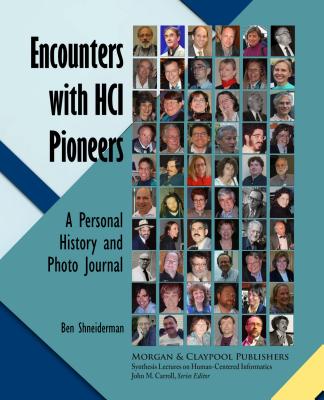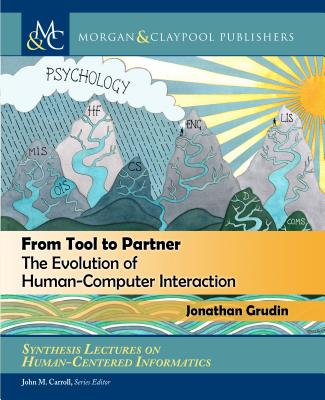Human-Computer Interaction in the New Millennium
暫譯: 新千年的人機互動
John M. Carroll
- 出版商: Addison Wesley
- 出版日期: 2001-08-18
- 售價: $2,130
- 貴賓價: 9.5 折 $2,024
- 語言: 英文
- 頁數: 752
- 裝訂: Paperback
- ISBN: 0201704471
- ISBN-13: 9780201704471
已絕版
買這商品的人也買了...
-
 Data Mining: Concepts and Techniques
Data Mining: Concepts and Techniques$2,510$2,385 -
 XML 程式設計藝術 (XML How to Program)
XML 程式設計藝術 (XML How to Program)$950$855 -
 Perl 學習手冊 (Learning Perl, 3/e)
Perl 學習手冊 (Learning Perl, 3/e)$580$458 -
 Interaction Design Beyond Human-computer interaction
Interaction Design Beyond Human-computer interaction$1,050$1,029 -
 LPI Linux 資格檢定 (LPI Linux Certification in a Nutshell)
LPI Linux 資格檢定 (LPI Linux Certification in a Nutshell)$880$695 -
 ASP.NET 資料庫程式設計─使用 C#
ASP.NET 資料庫程式設計─使用 C#$550$435 -
 ASP.NET 程式設計徹底研究
ASP.NET 程式設計徹底研究$590$466 -
 Java 2 教學手冊 SDK 1.4版 (Beginning Java 2 SDK 1.4 Edition)
Java 2 教學手冊 SDK 1.4版 (Beginning Java 2 SDK 1.4 Edition)$780$616 -
 C# Primer Plus 中文版 (C# Primer Plus)
C# Primer Plus 中文版 (C# Primer Plus)$680$537 -
 鳥哥的 Linux 私房菜-伺服器架設篇
鳥哥的 Linux 私房菜-伺服器架設篇$750$638 -
 鳥哥的 Linux 私房菜─基礎學習篇增訂版
鳥哥的 Linux 私房菜─基礎學習篇增訂版$560$476 -
 CCNA Self-Study: Interconnecting Cisco Network Devices (ICND) 640-811, 640-801, 2/e
CCNA Self-Study: Interconnecting Cisco Network Devices (ICND) 640-811, 640-801, 2/e$2,250$2,138 -
 JSP 2.0 技術手冊
JSP 2.0 技術手冊$750$593 -
 密碼學與網路安全-原理與實務 (Cryptography and Network Security: Principles and Practices, 3/e)
密碼學與網路安全-原理與實務 (Cryptography and Network Security: Principles and Practices, 3/e)$680$537 -
 Effective C++ 國際中文版(最新修訂本), 2/e
Effective C++ 國際中文版(最新修訂本), 2/e$480$379 -
 $525Physical Computing: Sensing and Controlling the Physical World with Computers (Paperback)
$525Physical Computing: Sensing and Controlling the Physical World with Computers (Paperback) -
 Paper Prototyping: The Fast and Easy Way to Design and Refine User Interfaces (Paperback)
Paper Prototyping: The Fast and Easy Way to Design and Refine User Interfaces (Paperback)$2,060$1,957 -
 Linux 程式設計教學手冊
Linux 程式設計教學手冊$780$616 -
 ASP.NET 徹底研究進階技巧─高階技巧與控制項實作
ASP.NET 徹底研究進階技巧─高階技巧與控制項實作$650$507 -
 實戰 PHP 5 & MySQL 5 (PHP and MySQL Web Development, 3/e)
實戰 PHP 5 & MySQL 5 (PHP and MySQL Web Development, 3/e)$680$578 -
 $1,020Activity-Centered Design: An Ecological Approach to Designing Smart Tools and Usable Systems (Hardcover)
$1,020Activity-Centered Design: An Ecological Approach to Designing Smart Tools and Usable Systems (Hardcover) -
 Where the Action Is: The Foundations of Embodied Interaction (Paperback)
Where the Action Is: The Foundations of Embodied Interaction (Paperback)$1,350$1,283 -
 Java 2 全方位學習(J2SE 5.0 增修版)
Java 2 全方位學習(J2SE 5.0 增修版)$750$593 -
 $600Digital Ground: Architecture, Pervasive Computing, and Environmental Knowing (Paperback)
$600Digital Ground: Architecture, Pervasive Computing, and Environmental Knowing (Paperback) -
 $1,020Smart Materials and Technologies in Architecture (Paperback)
$1,020Smart Materials and Technologies in Architecture (Paperback)
相關主題
商品描述
Human-computer interaction (HCI) has long been a focal area for innovative, multidisciplinary computing research and development. At the dawn of a new millennium, it is time to ask where this increasingly important field is going. What are the critical technical challenges and opportunities that will define HCI work in the years to come? What are the approaches that will sustain and enhance the vitality and effectiveness of HCI? In what ways will HCI differ from what it is today?
In this unique book, John M. Carroll, himself a prominent contributor to HCI understanding, presents answers to these questions from a number of leaders in the field. Half of the chapters are based on articles that first appeared in special issues of ACM Transactions on Computer-Human Interaction and Human-Computer Interaction, revised and rewritten for a broader audience. The other half are original contributions, describing some of the latest work being done in HCI and providing a striking vision of the future. No single volume could cover the entire scope of HCI, but these selected writings will give you a good glimpse of the energy and creativity now driving HCI forward.
Topics covered include:- The influence of the cognitive sciences on HCI
- Usability engineering, including both measurement and design
- Addressing interface concerns earlier in the development process; participatory design
- New user interface software tools for speech and voice, immersive displays, and position-sensing controls
- New interfaces and methodologies for supporting collaboration
- Interfaces that support navigation through vast amounts of information
- Situated computing and the integration of computers with real environments
- Learner-centered design; community computing
- Social and societal impacts
Whether you are a specialist in HCI, a software designer or developer, or simply a curious computer user, you will find here a wealth of interesting and stimulating ideas on the future of our interactions with computers.
Table of Contents
Preface.
List of Figures.
Introduction.
Human-Computer
Interaction: The Past and the Present, John M. Carroll.
I. MODELS, THEORIES, AND FRAMEWORKS.
1. On the Effective Use and Reuse of HCI Knowledge, Alistair
Sutcliffe.
2. Systems, Interactions, and Macrotheory, Philip Barnard,
Jon May, David Duke, David Duce.
3. Design in the MoRAS, George W.
Furnas.
4. Distributed Cognition: A New Foundation for Human-Computer
Interaction, James D. Hollan, Edwin Hutchins, Davis Kirsh.
II. USABILITY ENGINEERING METHODS AND CONCEPTS.
5. The Efficient Use of Complex Computer Systems, Suresh K. Bhavnani,
Bonnie E. John.
6. User Interface Evaluation: How Cognitive Models Can
Help, Frank E. Ritter, Gordon D. Baxter, Gary Jones, Richard M. Young.
7. HCI in the Global Knowledge-Based Economy: Designing to Support Worker
Adaptation, Kim J. Vicente.
8. Let's Stop Pushing the Envelope and
Start Addressing It: The Reference Task Agenda for HCI, Steve Whittaker,
Loren Terveen, Bonnie A. Nardi.
9. The Maturation of HCI: Moving Beyond
Usability Toward Holistic Interaction, Kenneth Maxwell.
III. USER INTERFACE SOFTWARE AND TOOLS.
10. Past, Present, and Future of User Interface Software Tools, Brad
Myers, Scott E. Hudson, Randy Pausch.
11. Creating Creativity: User
Interfaces for Supporting Innovation, Ben Schneiderman.
12. Towards a
Human-Centered Interaction Architecture, Terry Winograd.
IV. GROUPWARE AND COOPERATIVE ACTIVITY.
13. Computer Mediated Communications: Past and Future, Murray Turoff,
Starr Roxanne Hiltz, Michael Bieber, Brian Whitworth, Jerry Fjermestad.
14. The Intellectual Challenge of CSCW: The Gap between Social Requirements
and Technical Feasibility, Mark S. Ackerman.
15. Social Translucence:
An Approach to Designing Systems That Support Social Processes, Thomas
Erickson, Wendy A. Kellogg.
16. Transcending the Individual Human Mind:
Creating Shared Understanding Through Collaborative Design, Ernesto Arias,
Hal Eden, Gerhard Fischer, Andrew Gorman, Eric Scharff.
17. The
Development of Cooperation: Five Years of Participatory Design in the Virtual
School, John M. Carroll, George Chin, Mary Beth Rosson, Dennis C. Neale.
18. Distance Matters, Gary M. Olson, Judith S. Olson.
V. MEDIA AND INFORMATION.
19. Designing the User Interface for Multimodal Speech and Gesture
Applications: State-of-the-Art Systems and Research Directions for 2000 and
Beyond, Sharon Oviatt, Phil Cohen, Bernhard Suhm, John Bers, Lizhong Wu,
Thomas Holzman, Terry Winograd, John Vergo, Lisbeth Duncan, James Landay, Jim
Larson, David Ferro.
20. Technologies of Information: HCI and the
Digital Library, Andrew Dillon.
21. Intelligent Interfaces, Henry
Lieberman.
22. Human-Computer Collaboration in Recommended Systems,
Loren Terveen, Will Hill.
VI. INTEGRATING COMPUTATION AND REAL ENVIRONMENTS.
23. Ubiquitous Computing: Past, Present, and Future, Gregory Abowd,
Elizabeth Mynatt.
24. Situated Computing: The Next Frontier for HCI
Research, Kevin Mills, Jean Scholtz.
25. Roomware: Towards the Next
Generation of Human-Computer Interactions Based on an Integrated Design of Real
and Virtual Worlds, Norbert A. Streitz, Peter Tandler, Christian
Muller-Tomfelde, Shin'ichi Konomi.
26. Emerging Frameworks for Tangible
User Interfaces, Brygg Ullmer, Hiroshi Ishii.
VII. HCI AND SOCIETY.
27. Learner-Centered Design: Reflections and New Directions, Chris
Quintana, Andrew Carra, Joseph Krajcik, Elliot Soloway.
28. HCI Meets
the “Real World” : Designing Technologies for Civic Sector Use, Doug
Schuler.
29. Beyond Bowling Together: SocioTechnical Capital, Paul
Resnick.
Index.
List of Contributors.
商品描述(中文翻譯)
人機互動(HCI)長期以來一直是創新、多學科計算研究與開發的焦點領域。在新千年的曙光下,現在是時候思考這個日益重要的領域將走向何方。未來幾年,HCI工作將面臨哪些關鍵的技術挑戰與機會?哪些方法將持續並增強HCI的活力與有效性?HCI將以何種方式與今天的狀況有所不同?
在這本獨特的書中,約翰·M·卡羅爾(John M. Carroll),他本人是HCI理解的重要貢獻者,從多位領域領袖那裡提出了這些問題的答案。書中一半的章節基於最初出現在《ACM Transactions on Computer-Human Interaction》和《Human-Computer Interaction》特刊中的文章,經過修訂和重寫,以適應更廣泛的讀者群。另一半則是原創貢獻,描述了一些HCI領域最新的研究成果,並提供了對未來的驚人願景。雖然沒有單一的卷冊能涵蓋HCI的全部範疇,但這些精選的著作將讓你一窺當前推動HCI前進的能量與創造力。
涵蓋的主題包括:
- 認知科學對HCI的影響
- 可用性工程,包括測量與設計
- 在開發過程中更早地解決介面問題;參與式設計
- 用於語音和聲音的新用戶介面軟體工具、沉浸式顯示和位置感應控制
- 支持協作的新介面和方法論
- 支持在大量資訊中導航的介面
- 情境計算及計算機與真實環境的整合
- 以學習者為中心的設計;社區計算
- 社會和社會影響
無論你是HCI專家、軟體設計師或開發者,還是單純好奇的電腦使用者,你都會在這裡找到大量有趣且激發思考的想法,關於我們與電腦互動的未來。
目錄
前言
圖表清單
導言
人機互動:過去與現在,約翰·M·卡羅爾
I. 模型、理論與框架
1. HCI知識的有效使用與重用,阿利斯泰爾·薩特克利夫(Alistair Sutcliffe)
2. 系統、互動與宏觀理論,菲利普·巴納德(Philip Barnard)、喬恩·梅(Jon May)、大衛·杜克(David Duke)、大衛·杜斯(David Duce)
3. MoRAS中的設計,喬治·W·弗納斯(George W. Furnas)
4. 分佈式認知:人機互動的新基礎,詹姆斯·D·霍蘭(James D. Hollan)、愛德溫·哈欽斯(Edwin Hutchins)、戴維·基爾什(Davis Kirsh)
II. 可用性工程方法與概念
5. 複雜計算機系統的有效使用,蘇雷什·K·巴夫納尼(Suresh K. Bhavnani)、邦妮·E·約翰(Bonnie E. John)
6. 用戶介面評估:認知模型如何提供幫助,法蘭克·E·里特(Frank E. Ritter)、戈登·D·巴克斯特(Gordon D. Baxter)、加里·瓊斯(Gary Jones)、理查德·M·楊(Richard M. Young)
7. 全球知識型經濟中的HCI:設計以支持工人的適應,金·J·維森特(Kim J. Vicente)
8. 讓我們停止推進邊界,開始解決它:HCI的參考任務議程,史蒂夫·惠特克(Steve Whittaker)、洛倫·特維倫(Loren Terveen)、邦妮·A·納爾迪(Bonnie A. Nardi)
9. HCI的成熟:超越可用性走向整體互動,肯尼斯·麥克斯韋(Kenneth Maxwell)
III. 用戶介面軟體與工具
10. 用戶介面軟體工具的過去、現在與未來,布拉德·邁爾斯(Brad Myers)、斯科特·E·哈德森(Scott E. Hudson)、蘭迪·保許(Randy Pausch)
11. 創造創意:支持創新的用戶介面,班·施奈德曼(Ben Schneiderman)
12. 朝向以人為中心的互動架構,特里·溫格拉德(Terry Winograd)
IV. 群件與合作活動
13. 計算機中介通信:過去與未來,穆雷·圖羅夫(Murray Turoff)、斯塔·羅克薇·希爾茨(Starr Roxanne Hiltz)、邁克·比伯(Michael Bieber)、布萊恩·惠斯沃斯(Brian Whitworth)、傑瑞·費爾梅斯塔(Jerry Fjermestad)
14. CSCW的智力挑戰:社會需求與技術可行性之間的差距,馬克·S·阿克曼(Mark S. Ackerman)
15. 社會半透明性:設計支持社會過程的系統的一種方法,托馬斯·埃里克森(Thomas Erickson)、溫迪·A·凱洛格(Wendy A. Kellogg)
16. 超越個體人類思維:通過協作設計創造共享理解,恩內斯托·阿里亞斯(Ernesto Arias)、哈爾·伊登(Hal Eden)、格哈德·費舍爾(Gerhard Fischer)、安德魯·戈曼(Andrew Gorman)、埃里克·沙爾夫(Eric Scharff)
17. 合作的發展:虛擬學校中五年的參與式設計,約翰·M·卡羅爾(John M. Carroll)、喬治·陳(George Chin)、瑪麗·貝絲·羅森(Mary Beth Rosson)、丹尼斯·C·尼爾(Dennis C. Neale)
18. 距離的重要性,加里·M·奧爾森(Gary M. Olson)、朱迪思·S·奧爾森(Judith S. Olson)
V. 媒體與資訊
19. 為多模態語音與手勢應用設計用戶介面:2000年及以後的最先進系統與研究方向,莎朗·奧維亞特(Sharon Oviatt)、菲爾·科恩(Phil Cohen)、伯恩哈德·蘇姆(Bernhard Suhm)、約翰·伯斯(John Bers)、李忠·吳(Lizhong Wu)、托馬斯·霍茲曼(Thomas Holzman)、特里·溫格拉德(Terry Winograd)、約翰·維爾戈(John Vergo)、莉斯貝斯·鄧肯(Lisbeth Duncan)、詹姆斯·蘭代(James Landay)、吉姆·拉爾森(Jim Larson)、大衛·費羅(David Ferro)
20. 資訊技術:HCI與數位圖書館,安德魯·迪倫(Andrew Dillon)
21. 智能介面,亨利·利伯曼(Henry Lieberman)
22. 推薦系統中的人機協作,洛倫·特維倫(Loren Terveen)、威爾·希爾(Will Hill)
VI. 整合計算與真實環境
23. 無所不在的計算:過去、現在與未來,格雷戈里·阿博德(Gregory Abowd)、伊莉莎白·米納特(Elizabeth Mynatt)
24. 情境計算:HCI研究的下一個前沿,凱文·米爾斯(Kevin Mills)、珍·肖爾茨(Jean Scholtz)
25. 房間設備:朝向基於真實與虛擬世界整合設計的人機互動下一代,諾伯特·A·斯特里茨(Norbert A. Streitz)、彼得·坦德勒(Peter Tandler)、克里斯蒂安·穆勒-湯菲爾德(Christian Muller-Tomfelde)、近藤信一(Shin'ichi Konomi)
26. 有形用戶介面的新興框架,布萊格·烏爾默(Brygg Ullmer)、石井裕(Hiroshi Ishii)
VII. HCI與社會
27. 以學習者為中心的設計:反思與新方向,克里斯·昆塔納(Chris Quintana)、安德魯·卡拉(Andrew Carra)、約瑟夫·克拉伊奇克(Joseph Krajcik)、艾略特·索洛威(Elliot Soloway)
28. HCI與“真實世界”的相遇:為公民部門使用設計技術,道格·舒勒(Doug Schuler)
29. 超越一起打保齡球:社會技術資本,保羅·雷斯尼克(Paul Resnick)
索引
貢獻者名單












